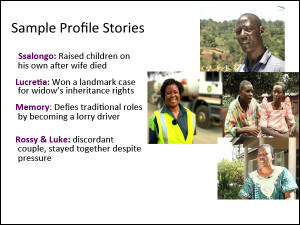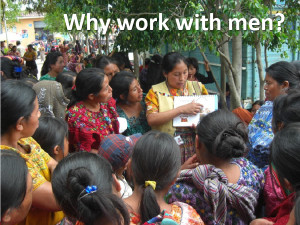Exploring Gender Transformative Approaches to SBCC: Webinar Recap
On September 22, HC3 hosted the tenth installment of the Health Communication Innovation Webinar Series on gender transformative approaches and social behavior change communication (SBCC).
Panelists included Jane Brown, Senior Program Officer at the Johns Hopkins Center for Communication Programs (CCP); Dr. Lydia Clemmons, Senior Advisor, Social and Behavior Change Communications at The Manoff Group; Jane Kato-Wallace, Senior Program Officer at Promundo; and Haydée Lemus Argueta, Communication Specialist at PSI PASMO/Guatemala.
A gender transformative approach seeks to redress gender disparities in all aspects of society; it is a negotiated process that considers the local as well as global, historical and socio-cultural contexts that shape human behavior. It includes interventions that challenge underlying gender norms and stereotypes that perpetuate inequities, as well as interventions that offer more equitable alternatives for individuals, families and communities.
Gender approaches have become, for many, synonymous with the word “women,” and “doing gender” means simply promoting women’s participation in development programs, but in actuality, as all panelists reminded us, true transformative and lasting change will come only by empowering people of all genders to achieve their potential as productive members of society.
The Evolution of a Gender Transformative Tool
 “Arab Women Speak Out” (AWSO) is a tool used with women in the Middle East to spark critical analysis, provide skills building, challenge stereotypes and build women’s self esteem. While the Johns Hopkins CCP tool methodology has evolved in response to different contexts, a lot of its central aspects have remained the same.
“Arab Women Speak Out” (AWSO) is a tool used with women in the Middle East to spark critical analysis, provide skills building, challenge stereotypes and build women’s self esteem. While the Johns Hopkins CCP tool methodology has evolved in response to different contexts, a lot of its central aspects have remained the same.
At last count, over 1.5 million women had benefited from AWSO. Out of the AWSO methodology came the development of a toolkit called “African Transformation” (AT), designed regionally to engage both women and men in a similar process around critical analysis, dialogue and action.
“What we do through these interactive tools is create safe spaces that provide disruption, enabling people to think about things differently and critically reflect on how gender beliefs and practices are operating in their lives,” said Jane Brown.
AWSO and AT have both led to significant results. AWSO has inspired increased participation in new business ventures, community meetings and community efforts to improve healthcare. AT inspired a significantly more equitable view of men’s and women’s roles and a recognized importance of shared decision-making and the benefits that accrue when women and men work together. The program also had a positive effect on men’s perceptions of men who assumed non-traditional roles and evidence of decreased tolerance for partner violence – among other notable impacts.
Understanding and Facilitating Gender Transformation for Improved Nutrition, Health and Education Outcomes
Following Brown’s presentation, Dr. Clemmons shared snapshots of some of the SBCC Research and Design The Manoff Group has been doing to support gender transformation in families, households and peer groups.
 The Manoff Group uses a menu of qualitative research methods to help understand what gender means to people in their unique socio-cultural setting; these include:
The Manoff Group uses a menu of qualitative research methods to help understand what gender means to people in their unique socio-cultural setting; these include:
- The pile sorts method, in which they ask research participants to quickly place select images into one of several piles based on where they think the image fits best.
- The picture codes method, in which they show participants pictures and ask them to explain what they see or to tell a story around it.
- Diagnostic role plays (DRPs), or improv-style role-plays, where two or more participants are asked to act out a specific situation provided by the researcher and researchers carefully observe and compare interpretations across groups.
- Creative concept testing, or the development of a story or idea that resonates with men and women and transforms society’s expectations. The right creative concept can help address gender transformative roles in a way that “feels right” and “make sense” to everyone.
In Ethiopia, the USAID/ENGINE Project used a “Queen Bee” creative concept to help improve maternal nutrition practices in rural smallholder farming communities – drawing a parallel between the way a hive cares for a Queen Bee and the way a family should care for a pregnant or lactating woman. The tactic promoted supportive family actions and shifted social expectations of gender roles and relationships in an environment where women were expected to be selfless and neglect their own maternal nutrition health for the wellbeing of others.
All of the research methods Dr. Simmons highlighted have helped The Manoff Group design SBCC around supportive “we behaviors,” which emphasis shared responsibility include a focus on peer networks and building group efficacy around new or enhanced gender norms.
Engaging Men and Boys in Gender-Transformative Programming
Jane Kato-Wallace continued the discussion with a focus on the importance of including men and boys in gender transformative approaches. Promundo’s understanding of men and boys at a country level is largely informed by the International Men and Gender Equality Survey (IMAGES), one of the only and largest surveys of its kind that seeks to collect data on men and women’s behaviors, attitudes, perceptions of various dimensions of gender.
IMAGES results reveal that violence is a defining feature of men’s and boys’ lives; between 10-44% of men in the countries surveyed witnessed violence in the home. Greater proportions of men have suffered psychological violence and neglect, and these experiences often serve as risk factors that perpetuate men’s use of violence later on in life. Men’s use of violence has been found to be a learned behavior, rooted in the ways they were socialized during childhood.
 Kato-Wallace said that one of the ways in which we can break the inter-generational transmission of violence is to promote the inter-generational transmission of care. The MenCare campaign is one of the ways in which Promundo has engaged men and boys around the prevention of violence and the promotion of gender equality. The campaign positions fatherhood as a positive entry point — tapping into men’s own self-interest to trigger change.
Kato-Wallace said that one of the ways in which we can break the inter-generational transmission of violence is to promote the inter-generational transmission of care. The MenCare campaign is one of the ways in which Promundo has engaged men and boys around the prevention of violence and the promotion of gender equality. The campaign positions fatherhood as a positive entry point — tapping into men’s own self-interest to trigger change.
“At the individual and relationship level, we’ve used methodologies that aim to create safe spaces where men and women together can critically reflect on and challenge gender norms which perpetuate inequality within the home and seek to promote positive alternative practices,” said Kato-Wallace. “We also utilize a similar approach working with youth.”
New Masculinity and Family Planning: A gender transformative approach to SBCC in rural Guatemala
Haydée Lemus Argueta closed out the hour with the story of PSI’s Supporting International Family Planning Organizations (SIPFO) program, a USAID-funded initiative supporting the Ministry of Health in reducing maternal mortality and chronic malnutrition in the Western Highlands of Guatamala.
 Argueta explained that in order to be successful, the project had to engage men, too, since Guatamala has a patriarchal culture in which machismo prevails as a social norm and family planning is negatively perceived.
Argueta explained that in order to be successful, the project had to engage men, too, since Guatamala has a patriarchal culture in which machismo prevails as a social norm and family planning is negatively perceived.
To raise awareness around a form of new masculinity that supports women, PSI designed a gender transformative approach that includes four SBCC interventions:
- 58 training sessions on gender and new masculinities – targeting health providers and building institutional capacity.
- Interpersonal communication – approaching and engaging more than 3,000 men around family planning at the community health level through community health workers.
- Advocacy at local and national levels – employing local leaders and authorities to encourage the critical assessment of existing harmful gender stereotypes.
- 5-month – 1+year long mass media campaign – disseminating a communications campaign (including radio broadcasts, posters, flyers, and videos) with help from the Men’s National Network for New Masculinity around new masculinity roles linked to family planning.
The campaign was used by community health workers, health providers and civil society leaders to promote conversations around new masculinity roles. Four roles were framed as the shared responsibility of the man and the woman: the education of children, nutrition of the family, decisions about money use and family planning.
Civil society leaders said the campaign “opened eyes, removed customs, and promoted gender equity.”
—
Want to continue the conversation around gender transformative approaches in SBCC? Visit Springboard with questions or ideas and keep the discussion going.
Download the Presentations and Listen to the Recording
__
This webinar is the latest in an ongoing series produced over the past year and a half by the Health Communication Capacity Collaborative (HC3), a five-year global project funded by USAID and led by Johns Hopkins Center for Communication Programs in partnership with Management Sciences for Health, NetHope, Population Services International, Ogilvy Public Relations, Internews and Forum One Communications. HC3’s main objective is to strengthen capacity to design, implement and evaluate state-of-the-art social and behavior change communication programs. The Innovation Webinar Series works to help achieve this objective by spotlighting a broad range of health communication innovations and engaging a diverse audience around a meaningful mix of theory and practical examples, drawn from academic, public and private sectors.
—
The following external resources were shared by participants throughout the presentation:
Johns Hopkins CCP | African Transformation (AT) toolkit: https://www.k4health.org/sites/default/files/african_transformation_toolkit.pdf
Johns Hopkins CCP | African Transformation (AT) video profiles:
https://www.youtube.com/playlist?list=PLflIHdtzuE_EabdXRuoHUypuoPm-k54LT
Additional downloads that accompany the facilitator’s guide:
https://www.k4health.org/toolkits/bridge-ii-project-toolkit/african-transformation
The Manoff Group manual on Diagnostic Role Plays (DRP): http://www.manoffgroup.com/documents/DRPguide.pdf
Example of a project similar to African Transformation | The Men’s Story Project engages men in publicly sharing personal stories that challenge masculinity norms through the lens of their own experience. The project YouTube channel has approximately 40 stories: http://www.youtube.com/user/mensstoryproject








Leave a Reply
Want to join the discussion?Feel free to contribute!